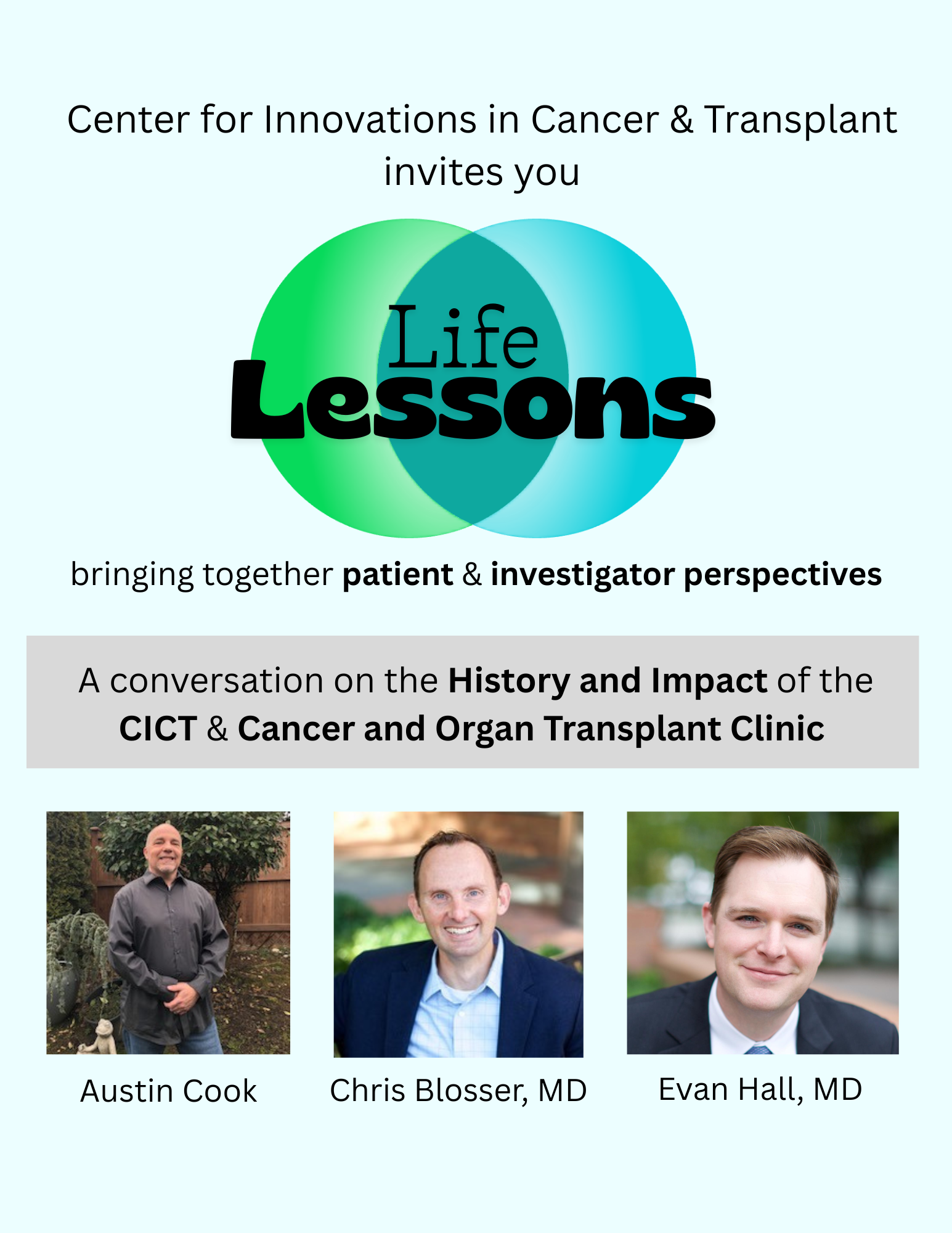Cancer is a leading cause of death among kidney transplant recipients (KTRs) and may disproportionately affect disadvantaged individuals. We assessed the association between neighborhood socioeconomic status and cancer outcomes among KTRs in the US.
Transforming the lives of people with cancer and organ transplants through integrated healthcare and research.

Watch intro video (4 min)
The Center for Innovations in Cancer & Transplant was founded with the following goals:
- To provide outstanding multidisciplinary clinical care for pre- and post-transplant patients with cancer.
- To lead exceptional, multidimensional, patient-focused research of cancer before and after organ transplant through a robust bioregistry and collaborative research network.
We seek to do this through a first-of-its kind clinic, a new bioregistry, and our own original research.
Learn more about the Center
Clinic
The first-of-its-kind multidisciplinary consult clinic for organ transplant candidates and recipients with cancer.
Bioregistry
A registry to integrate patient data from cancer centers and transplant programs around the world.
Research
Investigating the immune mechanisms and epidemiology of cancer with solid organ transplantation.
Recent publications
The Association between Neighborhood Socioeconomic Status and Posttransplant Cancer Outcomes among Kidney Transplant Recipients in the United States
Yue Harn Ng… Bessie Young… Christopher Blosser… Eric Engels
Kidney360
Original Work
DOI: 10.34067/KID.0000000979
PMID: 41032374
We evaluated first-time KTRs through a linkage between US transplant and cancer registries (2000-2019). The Yost index, which incorporates neighborhood measurements of income, educational level, housing, and employment, was categorized into quintiles, with the lowest quintile (Q1) corresponding to the most disadvantaged neighborhood. We used Poisson regression to compare the association of Yost quintiles with cancer incidence overall and with seven common cancer types (colorectum, lung, female breast, prostate, kidney, melanoma, and non-Hodgkin lymphoma) as well as to compare the Yost index with cancer stage at diagnosis. Cox regression was used to evaluate cancer-specific mortality.
We included 168,028 KTRs. Overall cancer incidence was 12.3 per 1,000 person-years (n=11,146 cases) with no overall difference across Yost quintiles (p-trend=0.893). However, KTRs from the most disadvantaged neighborhoods had higher lung cancer incidence (adjusted incidence rate ratio [IRR] 1.44, 95% confidence interval [95%CI] 1.19-1.73, Q1 vs. Q5; p-trend=0.001) and lower prostate cancer incidence (IRR 0.76, 95%CI 0.63-0.92, Q1 vs. Q5; p-trend=0.022). KTRs in more disadvantaged areas who were diagnosed with melanoma were more likely to present with regional or distant stage cancer (p-trend=0.022). After a cancer diagnosis, cancer-specific mortality was higher among KTRs in lower Yost quintiles (adjusted hazard ratio 1.18, 95%CI 1.05-1.32 for Q1 vs. Q5; p-trend=0.004), although trends were not significant for individual cancer types.
KTRs from disadvantaged neighborhoods have increased lung cancer risk and reduced prostate cancer risk, and are more likely to present with advanced-stage melanoma. After a cancer diagnosis, KTRs from disadvantaged neighborhoods are also more likely to die from their cancer. These results point to important disparities among KTRs in cancer screening and treatment.
Merkel cell carcinoma in solid organ transplant recipients: prognosis and response to immunotherapy
Tomoko Akaike… Christopher D. Blosser… Paul T. Ngheim
British Journal of Dermatology
Original Work
DOI: 10.1093/bjd/ljaf304
Merkel cell carcinoma (MCC) is an aggressive skin cancer with an increased risk of occurrence in immunocompromised patients, including solid organ transplant recipients (SOTRs). As the number of SOTRs rises worldwide, MCC cases in this population are also expected to increase. While anti-programmed cell death 1 ligand 1 (anti-PD-L1; also known as anti-programmed death ligand 1) immunotherapy generates durable tumour responses in ∼50% of immunocompetent (IC) patients with advanced MCC, its efficacy and safety in SOTRs remain uncertain as these patients have been excluded from most clinical trials.
Objectives:
To compare baseline characteristics and outcomes among SOTRs and IC patients with MCC, and to evaluate the efficacy and toxicity of anti-PD-L1 in SOTRs.
Methods:
We queried an MCC registry from our institution (April 1988–May 2024), extracting data on demographics, anti-PD-L1 response and immunosuppression regimens, along with incidence of allograft rejection and failure, for analysis.
Results:
We identified 1214 patients with MCC (37 SOTRs and 1177 IC patients); 8 of 37 SOTRs received anti-PD-L1. Median time from SOT to MCC diagnosis was 10 years (range 0.4–43). The proportion of patients with advanced MCC (≥ stage III) was 76% in SOTRs compared with 51% in IC patients (P = 0.004). SOTR status was associated with worse outcomes, including higher rates of disease progression [adjusted hazard ratio (aHR) 2.3], MCC-specific mortality (aHR 3.0) and overall mortality (aHR 3.9) (all P < 0.001 for the respective comparisons). Median time to death due to MCC for SOTRs was 2.7 years; 24% of SOTRs died within one year of diagnosis, in contrast with just 4% of IC patients. Median time to MCC progression for SOTRs was 8.6 months vs. 12 years for IC patients. Among SOTRs, 70% developed distant metastases within 2 years vs. 25% of IC patients. All eight MCC SOTRs treated with anti-PD-L1 were kidney transplant recipients, with five (63%) experiencing an objective response (two complete response, three partial response). However, two patients (29%) experienced irreversible graft failure within 9 weeks.
Conclusion:
SOTR status is a significant independent risk factor of a worse prognosis for MCC. This study represents the largest cohort evaluating the efficacy and safety of anti-PD-L1 in SOTRs with advanced MCC, highlighting the potential benefits in this population.
Management recommendations for kidney transplantation in patients with plasma cell dyscrasia
Naoka Murakami…Christopher D. Blosser…Heather Landau
Kidney International
Original Work
DOI: 10.1016/j.kint.2025.07.011
Patients with plasma cell dyscrasias, including multiple myeloma, AL amyloidosis, and monoclonal gammopathy of renal significance, face a high burden of end-stage kidney disease, which limits survival and quality of life. Although kidney transplantation offers potential benefits, it remains underused because of the high risk of recurrence and historically poor outcomes. A multidisciplinary panel of transplant nephrologists, hematologists/oncologists, and pathologists convened to evaluate contemporary evidence and evolving strategies in kidney transplant for plasma cell dyscrasias and end-stage kidney disease.
Advances in plasma cell dyscrasia therapies are improving survival and expanding kidney transplant eligibility. However, key challenges remain, including optimizing hematologic response pre–kidney transplant and managing immunosuppression to mitigate recurrence and avoid infection complications. Ongoing research and multidisciplinary collaboration are essential to refine transplant selection, integrate biomarkers for risk stratification, and develop tailored post–kidney transplant surveillance. These efforts may increase access to kidney transplant and improve outcomes for patients with plasma cell dyscrasias and end-stage kidney disease.


